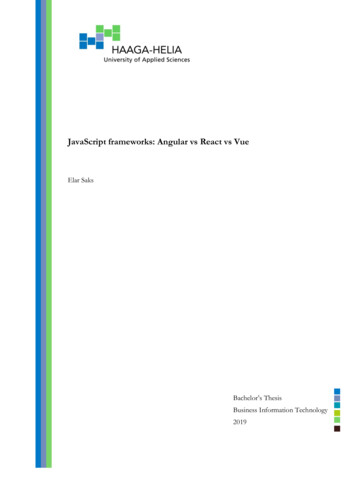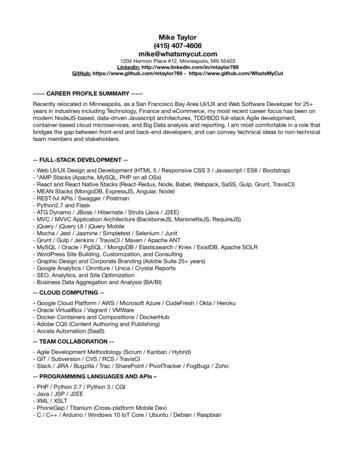
Transcription
JavaScript frameworks: Angular vs React vs VueElar SaksBachelor’s ThesisBusiness Information Technology2019
AbstractDateAuthorsElar SaksDegree programmeBusiness Information TechnologyReport/thesis titleNumber of pagesJavaScript frameworks: Angular vs React vs Vueand appendix pages42 1The aim of this study was to compare the three of the most popular JavaScript frameworks inpopularity, the difficulty of learning and in performance, so that the reader could make an educated decision when deciding which framework to learn or to use for the project.To understand the popularity of the frameworks, the data by the three most used software development cooperation platforms were collected and analyzed. React was found to be the mostpopular out of these three frameworks.The frameworks learning curve was compared by using its official technical documentation tolearn about its syntax, architecture, data management, lifecycle, and in the ease of using thirdparty libraries. For the writer of this study, Vue seemed to be the easiest to learn.To compare the framework's performance a simple single page application was built and testedin each framework. Vue proved to be the fastest performing framework.In the end, it was concluded that: React is the best framework to learn when looking for a job,Vue is the best framework for small scale applications that require fast performance. Angular ismost likely best suited for bigger more complex applications. Although, further research isneeded to compare frameworks when building large applications.Key wordsJavaScript frameworks, Angular, React, Vue.
Table of contents1 Introduction . 11.1Background . 11.1.1Angular . 11.1.2React . 21.1.3Vue . 21.2Objectives . 31.3Popularity . 31.4Learning curve . 31.5Performance . 31.6Out of scope . 41.7Objectives . 42 Frameworks Popularity . 52.1GitHub . 52.2Npm Trends . 62.3Stack Overflow . 63 Frameworks learning curve . 83.13.23.3Angular. 83.1.1Syntax. 83.1.2Architecture. 83.1.3Data management. 93.1.4Lifecycle . 103.1.5Third party packages . 11React . 113.2.1Syntax. 113.2.2Architecture. 113.2.3Data management. 113.2.4Application Lifecycle. 123.2.5Third Party Packages . 12Vue . 133.3.1Syntax. 133.3.2Architecture. 143.3.3Data management. 143.3.4Application lifecycle . 143.3.5Third-party packages . 154 Frameworks performance . 174.1Application design and shared parts. 17
4.2Testing environment . 194.2.14.34.44.5Testing . 19Angular. 204.3.1Root component: App. 204.3.2Menu component . 214.3.3Row component. 224.3.4Test results . 23React . 244.4.1Root component: App. 244.4.2Menu component . 264.4.3Row component. 264.4.4Test results . 27Vue . 274.5.1Root component: App. 274.5.2Menu component . 294.5.3Row component. . 294.5.4Test results . 305 Evaluation . 315.15.25.3Popularity . 315.1.1GitHub data . 315.1.2NPM Trends . 325.1.3Stack Overflow trends . 32Learning Curve . 335.2.1Syntax. 335.2.2Architecture. 335.2.3Data management. 335.2.4Lifecycle . 345.2.5Third party packages . 34Performance . 346 Conclusion . 376.1Popularity . 376.2Learning curve . 376.3Performance . 386.4Final conclusion . 38References . 39Appendices . 43Appendix 1. Vue Application Lifecycle (VueJS f). . 43
1IntroductionThis chapter will tell about thesis background, objectives, JavaScript frameworks to be studiedand the domains they are compared in.1.1BackgroundMajority of modern websites use JavaScript in some shape or form, to make the pages moreinteractive and to handle functionality. The traditional webpages are multi-page applications,where a new HTML document gets loaded every time the user changes page or its content.That is a relatively slow option compared top more modern version of a single-page application (SPA) development model, where only the parts that changed get fetched from the serverand updated. Using SPA model reduces application loading speeds and improves user experience.Single-page applications are gaining popularity, and so do the frameworks they are built-in.Frameworks dictate the application development workflow, reduce the development time andpossible errors. Each framework is different with its pros and cons, therefore selecting thecorrect one for the software project can be a strategic decision for a company and for the junior developer looking to add a new skill to his or her arsenal. As of 2019, Angular, React, andVue JS are some of the most popular JavaScript frameworks.1.1.1AngularAround 2008 and 2009 Misko Hevery and 2 other Google developers had spent 6 months onbuilding an internal feedback tool for Google, only to realize that it had become too difficultto continue, because it was hard to test the code. Misko and developers were using Googlesinternal Java framework called Google web toolkit. To write 1 label in HTML, it had to bewritten in Java, compiled and transformed into HTML and JavaScript to be displayed inbrowser.Misko challenged his manager Brad Green that he could do the whole project alone in 2weeks, using the technology that he and his friend Adam Abrons had built as a side project. Ittook him Misko 3 weeks. Brad was impressed and asked Misko to finish Google feedback toolwith Shyam Seshari and Igor Minor using Angular. After that Angular got open sourced on1
GitHub and became available to people outside of Google. It was named Angular because ofits use of HTML, that has angular brackets. (Gudelli 2017).When the second version of Angular was released, the framework was changed so much thatit could be considered a new framework. Angular versions 2 and up are backward compatibletill the Angular 2, but not with Angular 1. To avoid confusion, Angular 1 is now named Angular JS and Angular versions 2 and higher are named Angular. Angular JS is based on JavaScriptwhile Angular is based on JavaScript superset called TypeScript. (Dziwoki 2017).Modern day Angular is designed for all platforms: web, mobile web, native mobile and nativedesktop. It is built for speed on web and enables users to have control over scalability whilemeeting huge data requirements. It is supported by Googles and has millions of users worldwide (Angular a).1.1.2ReactReact is a JavaScript library for building user interfaces. React is built on 2011 by JordanWalke, a software engineer at Facebook. It got open sourced on 2013 and has gained additionsto it ever since. On 2015, React Native, a library for mobile devices was open-sourced and on2017, a library for virtual reality development, React360, was released. React is currently developed by Facebook and community of individual users. Facebook uses React in its projects,such as Facebook and Instagram. (Wikipedia).React is designed to enhance interactive UI development by making it easier to update theview when the data changes. It is done through dividing the view into smaller components,that can be composed to create complex UIs. Components are built in JavaScript instead oftemplates, enabling easy flow of data. (React a).1.1.3VueVue.js is a lightweight JavaScript library, created by Evan You. Before creating Vue, Evan hadbeen working in Google and Meteor. While in Google, Evan felt that using Angular in certainuse cases was too heavy and he decided to extract the parts he likes about Angular, to createhis light-weight library. On 2014 he shared his work with others on GitHub and that is howVue.js got started.2
Although Evan started Vue while working with Angular, he considers Vue being most similarwith the React, as its core idea is data binding and components, as in React. Compared to React, Vue puts more emphasis on the user experience, making it easy to pick up, if user knowsthe basics: HTML, JavaScript and CSS.After starting a crowdfunding campaign in Patreon on 2015, Evan has gathered a smallamount of private and corporate sponsors. That generates him enough cashflow that for nowhe is working fulltime on Vue JS. (Cromwell 2017).1.2ObjectivesEach framework is built different and will perform differently. This study aims to bring outthe possible advantages and disadvantages of each framework, enabling a reader to make aneducated decision when choosing between them. To achieve that the frameworks will be compared in 3 different categories: popularity, learning curve, and performance.1.3PopularityThe framework's popularity will be assessed by collecting and analysing data from major cloudplatforms related to software development, such as GitHub, NPM trends, and Stack Overflow.1.4Learning curveThe framework learning curve will be evaluated by comparing the framework syntax, architecture, data management, lifecycle, and in the ease of using third-party libraries. The informationfor that will be collected from each framework's technical documents.1.5PerformanceTo benchmark, the performance of the framework, small application with the same businesslogic is built in each framework. Then the application's production builds performances willbe measured using Google Chromes developer tools. Applications code will be uploaded tothe GitHub and working applications will be made accessible over the internet.3
1.6Out of scopeIn this study, JavaScript frameworks (Angular, React, Vue) are compared by building singlepage applications. Frameworks are not compared by building a multipage application. Frameworks: Angular, React, and Vue are compared only against each other and not against vanillaJavaScript. Under the name of 'Angular' in this thesis is meant JavaScript framework Angular2 and up.1.7ObjectivesEach framework is built different and will perform different. The aim of this study is to bringout the possible advantages and disadvantages of each framework, enabling a reader to makean educated decision when choosing between them. To do that, the frameworks will be compared in 3 different categories: popularity, learning curve and performance.4
2 Frameworks PopularityThis chapter provides an overview of data sources and data that was used to analyse the popularity of the framework. Data sources are picked so that all 3 of them are used by a large number of software developers around the world in their day to day operations. Data collectedfrom them is rather reflecting the situation as it is, instead of relying on opinions or hype.2.1GitHubGitHub markets itself as a software development platform, used by 31 million developers tohost and manage open source and business projects. (GitHub 2019). Hosting the code written by so many different developers for so many different purposes makes a GitHub uniqueand reliable source to try to gain understanding about the software development market andits trends. Table 1 displays information about Angular, React, and Vue repositories onGitHub.Table 1. Statistics about frameworks GitHub repositories as of 22.03.2019 (GitHub b; GitHubc; GitHub d.)GitHub StarsGitHub ForksGitHub IssuesAngular ReactVue46,572 125,734 133,47912,286 22,848 18,9902,331453184GitHub users can mark repositories they are interested in, with stars, making them easier tofind later and letting GitHub know on what topics the user is interested in knowing about. Itwill also show the appreciation towards the work of a repository maintainer. GitHub repositories are ranked and can be sorted in search based on the number of stars. (GitHub e 2019).Users can make personal copies of other user repositories and freely make changes on it, without affecting the original project. Copies act as a different path coming from an original project and can be updated by making a pull request to the source. Forks or paths can be recommended to merge with the original repository, making it better for everyone. The number offorks coming out from a repository is a good indicator of how many developers or teams aretrying to improve the project as an addition to original authors. (GitHub f 2019).5
GitHub has a built-in bug tracker called issues. It makes it easier to keep track of tasks and toshare them with a team (GitHub g 2019). The amount of issues could provide some ideaabout the scale and complexity of a project, as well as community support towards it.2.2Npm TrendsNode package manager is the largest software registry in the world. It allows open source developers to share and borrow JavaScript packages. It is also used by many organizations tomanage private projects (NPM.) NPM trends is a website that provides information about theamount of JavaScript packages downloaded via NPM throughout time. Figure 1 displays agraph about Angular, React, and Vue packages download during the past two years.Figure 1. Angular, React and Vue libraries downloads via NPM from 2017 till 2019 (NpmTrends)2.3Stack OverflowStack Overflow is an online platform where developers can ask and answer questions aboutprogramming. According to their homepage, more than 50 million people visit their StackOverflow every month (Stack Overflow a).This vast user base made up from developers and tech enthusiasts, discussing different programming languages makes it a perfect place to get an understanding of what the global developer community is using and talking about.6
Figure 2 is a graph displaying the percentage of total questions asked about the Angular, React, or Vue during the past ten years on Stack Overflow.Figure 2. Percentage of questions about Angular, React and Vue from 2009 to 2019 on StackOverflow (Stack Overflow b)7
3 Frameworks learning curveThis chapter provides a high-level technical overview of each framework. Information for thischapter is gathered from each framework’s documentation. Since these are all JavaScriptframeworks, they are all similar in their structure and workflows. That is why it was possible togather information about each framework on the five same topics: syntax, architecture, datamanagement, lifecycle, and third-party libraries.3.1AngularAgular’s homepage, Angular.io, has extensive documentation explaining the framework. It hastutorials to get new coming developers up to the level and it has documentation for more indepth topics, for more experienced Angular developers.3.1.1SyntaxAngular is written in HTML and TypeScript (Angular b). TypeScript is an open-source programming language developed and maintained by Microsoft, that adds static typing option toJavaScript and compiles into JavaScript (Wikipedia b).Angular template syntax is HTML, and almost all HTML is the valid Angular syntax, except script tag, that gets ignored by Angular to avoid script injection attacks. Angular extends regular HTML by making some JavaScript function expressions available in HTML.Double curly braces are used to render JavaScript content into the view (Angular c).3.1.2ArchitectureAngular applications are composed of NgModules, that are containers for a block of codededicated to an application domain, workflow, or a closely related set of capabilities. NgModules provide the compilation context for their content. They can contain components, serviceproviders, and other code files. They can export and import functionality from and to othermodules.8
Every Angular app has a root module, conventionally named AppModule, which provides thebootstrap mechanism that launches the application. Root module can include an unlimited hierarchy of child modules. Organizing code into distinct functional modules helps to managethe development of complex applications (Angular d).Angular partly utilizes the Model View Controller concept, by having a component as a controller and template as a view. Component controls the view that represents a patch of thescreen (Angular e). A component can contain a view hierarchy, made up of views from different modules. Illustration of it can be seen in figure 3., where a root component belongs tomodule A, and some of its child and grandchild components are imported from module B.Figure 3. Application view hierarchy (Angular f)3.1.3Data managementAngular supports two-way data binding, a mechanism for coordinating the parts of a templatewith the parts of a component. Data flows into the template from a component with theproperty binding and back from template to component with event binding, as illustrated inFigure 4.Figure 4. Data flow between component and a template (Angular g)9
Angular processes all data bindings once, for each JavaScript event, from a root of an application to all the child components in the component tree (Angular g).3.1.4LifecycleA component has a lifecycle managed by Angular. It creates the component, renders the component and updates the component when the data changes. Angular offers lifecycle hooks,giving a user an opportunity to interact with the code during the different stages of a component lifecycle.These are lifecycle hooks explained on the Angular website: ngOnChanges() gets called whenever one or more data properties changes ngOnInit() initializes the component when it is first created or when the NgOnChanges()is called ngDoCheck() is called during every change detection run, right after ngOnChanges() andngOnInit(). Is used to detect changes that Angular cannot or won’t detect itself ngOnChanges() and ngOnInit(). Is used to detect changes that Angular cannot or won’tdetect itself. ngAfterContentInit() – is called once after the first ngDoCheck(). Respond after Angularprojects external content into components view. ngAfterContentChecked() – is called after the ngAfterContentInit(). Let’s user to respond after Angular has checked the content projected into the component. ngAfterViewInit() – is called after ngAfterContentChecked(). Let’s user to respond after Angular has initialized the component and its children views. ngAfterViewChecked() – called after ngAfterViewInit() and every following ngAfterContentChecked(). Let’s user to respond after Angular has checked all the rendered componentand its children views. ngOnDestroy() – called just before Angular destroys the component. Cleans up beforecomponent destruction by unsubscribing to any observables, to avoid memory leaks.Other Angular sub-systems or third-party libraries might have their own lifecycle hooks apartfrom these component hooks (Angular h).10
3.1.5Third party packagesThird-party libraries can be used in Angular by installing them through NPM and importingthe provided functionality (Angular i). Third-party libraries extend Angular usability by addingreadymade styling and functionality.One of the most popular styling libraries for Angular is Angular Material. It consists of readymade Material Design components for Angular. They are fine-tuned for performance and integrate seamlessly with Angular (Angular j).3.2ReactReact has proper official documentation with multiple walk-through tutorials on their homepage reactjs.org, about how to get started. Main concepts are explained clearly and illustrativelyfor newcomers and for experienced users, documents are going in-depth on more advancedtopics.3.2.1SyntaxReact uses JSX syntax, that is JavaScript syntax extension. It is a mixture of JavaScript andHTML and might remind a template language to some, with the exception of having the fullpower of JavaScript (React b).3.2.2ArchitectureJSX is used to build elements that makeup components. React elements are plain objects andcheap to create, compared to browser DOM elements. Reacts virtual DOM takes care of updating the browsers DOM (React c). Virtual DOM (VDOM) is a concept where “virtual”representation of UI is kept in memory, and “real” DOM is synced via a library, such as ReactDOM. That removes the manual attribute and event handling and automates updating theDOM (React d).3.2.3Data managementReact components are the building blocks of application, that allow UI to be split into independent, reusable parts that can be thought about in isolation. Components are like JavaScript11
functions that accept inputs (called “props”) and return React elements. Components can refer to other components, making them reusable. Usually, React apps have a single “App”component on top of the view hierarchy (React e).Each React component can, but do not have to have a state. In React, the state is local and encapsulated into a single component. Data can be passed from parent components to childrenas props. Props are immutable and cannot be passed upward in a component tree hierarchy. Astate can be changed, and on state change, the component will be re-rendered. For better control over components, lifecycle React has built-in lifecycle functions providing quick and easycontrol over events, such as component mounting, unmounting, receiving data, etc (React f).3.2.4Application LifecycleFigure 3 illustrates components lifecycle. The virtual document object model is kept in thecache. Changes in data are passed down from top to down. React then compares the differences between virtual DOM and Real DOM and makes changes if necessary.Figure 5. React component tree and virtual DOM (Pngkey)React official documentation has an explanation of a component lifecycle and few lifecyclemethods, but not the full overview of a lifecycle or lifecycle hooks.3.2.5Third Party PackagesThird-party packages in React can be installed through NPM (Node Package Manager). Running third party libraries on top of React enhances its usability and adds extra functionality,such as two-way data binding and routing. Probably one of the most used third-party librariesfor React is Redux.12
Redux is a state container for a JavaScript application and can be used together with React. InRedux, the whole app state is stored in an object tree inside a single store. As the applicationgrows, the Redux store grows and can be divided into a tree-like structure, the same as the appcomponent tree. It might seem like overkill for smaller applications, but it will prove beneficialas the application scales up and gets more complex (Redux a).Figure 4. displays how Redux store receives data from the lowest component of a componenttree and can share it with the nodes higher up in the tree.Figure 6. Redux store distributing data (Edureka)3.3VueVue JS has in detail documentation and examples on their homepage vuejs.org, on about howto get started. Main concepts are explained thoroughly and illustrated with examples on theirhomepage and in jsfiddle.3.3.1SyntaxVue.js uses HTML -based template syntax, that gets binded to underlying Vue instance JavaScript. All Vue templates are valid HTML. Data coming from Vue application can be bindedinto HTML using the “Mustache” syntax (double curly braces), for example: p Message: {{ msg }} /p . Everything written insides these double curly braces will beevaluated as JavaScript in the data scope of a Vue instance (VueJS a).13
3.3.2ArchitectureVue applications are made up of reusable components called Vue instances, accepting thesame options as a new Vue instance, such as data, m
it could be considered a new framework. Angular versions 2 and up are backward compatible till the Angular 2, but not with Angular 1. To avoid confusion, Angular 1 is now named Angu-lar JS and Angular versions 2 and higher are named Angular. Angular JS is based on JavaScript while Angular is based on JavaScript superset called TypeScript.










